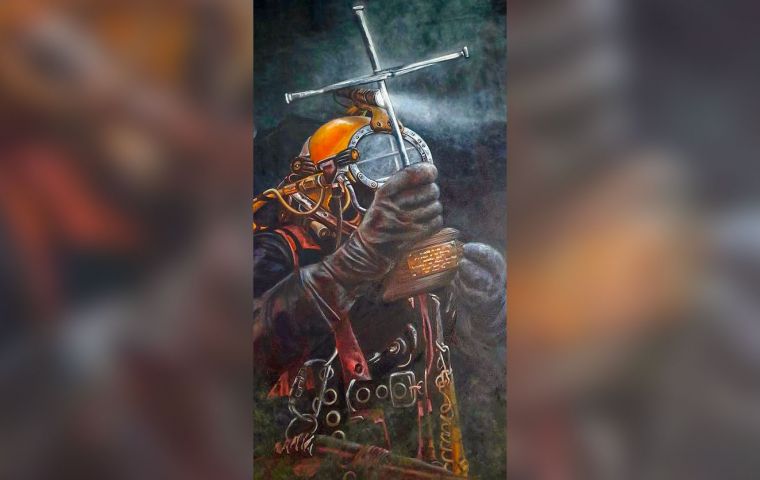MercoPress. South Atlantic News Agency
HMS Coventry recovered Cross of Nails commemorated on canvas
 Emerging from the depths a diver clasps the Cross – symbol of a city, a Royal Navy warship and hope over suffering
Emerging from the depths a diver clasps the Cross – symbol of a city, a Royal Navy warship and hope over suffering Four decades after the Cross of Nails was recovered from HMS Coventry off the Falklands, one of the team involved in the delicate operation has had it commemorated on canvas. Emerging from the depths a diver clasps the Cross – symbol of a city, a Royal Navy warship and hope over suffering – in a tribute to the men lost when the warship went down, and the men who dived to the wreck on the secret recovery operation.
Former clearance diver Ray Sinclair says the Cross of Nails is a “significant religious relic” and its history and importance to the Royal Navy, the Type 42 destroyer and her namesake city “cannot be understated”.
The original cross was fashioned by the Rev Arthur Philip Wales who found several large hand-forged carpenters' nails, each about 18 inches long, dating back to the mediaeval era in the still-smoldering ruins of Coventry Cathedral on the morning after the Midlands city was flattened by the Luftwaffe at the height of the Blitz in November 1940.
The clergyman used some wire to bind together three nails into the shape of a Latin cross, thus creating the original Cross of Nails, which became an icon of suffering in war, but also of human triumph over adversity and ultimately a symbol of peace and reconciliation.
When Coventry Cathedral was rebuilt in the aftermath of World War 2, other nails and roof spikes recovered from the ruins were saved, welded together, plated with silver and sent to cities in Germany which suffered badly from bombing including Kiel, Berlin and Dresden.
And when a new HMS Coventry joined the Fleet in the late 1970s, a Cross of Nails was donated to the destroyer as an enduring bond with the city. Kept in the captain’s cabin, it also became the centerpiece of the Sunday morning service aboard.
And that is where divers found it, among personal possessions of Captain David Hart-Dyke, HMS Coventry’s Commanding Officer on the fateful day of May 25 1982.
The destroyer was struck by three 250kg bombs on her port side while operating with HMS Broadsword off Pebble Island, north of the Falklands, in a bid to lure Argentine aircraft away from the bulk of the British amphibious force around San Carlos water.
The destroyer sank in 23 minutes, taking 19 men down with her, coming to rest on the seabed 330ft down.
She lay there for several months until the autumn of 1982 when a team of Royal Navy clearance divers was sent to recover top secret UK/NATO material and documents to prevent it falling into hostile hands.
Recovering the Cross – or some of Capt Hart-Dyke’s personal effects – was not strictly part of Operation Blackleg, but was done all the same.
The Cross was subsequently returned to Coventry Cathedral by the destroyer’s captain, loaned to next HMS Coventry until the Type 22 frigate was decommissioned in 2002, returned once more to Midlands, before again loaned to the next ship linked with the city, destroyer HMS Diamond – currently deployed on operations in the Mediterranean/Middle East.
More than 40 years on from the delicate recovery operation, Mr Sinclair asked award-winning South African artist Dave Coburn to capture the moment the cross was seen for the first time being carried towards the surface of the Atlantic.
“I wanted him to capture the light and the dark of the diving conditions the team worked in, but symbolically and spiritually to represent John 1:5: The light shines in the darkness, and the darkness did not overcome it,” he explained.
The resulting artwork which can be seen in Gosport’s refurbished town museum is dedicated to HMS Coventry’s dead, as well as all those involved in the recovery mission, not just the divers, who successfully completed their mission, recovering everything on the MOD manifest in the most physically and psychologically demanding of circumstances, but also their civilian support crew.
“To this day, Operation Blackleg has been the Royal Navy's finest achievement in deep saturation diving recovery from inside a warship – on the same page as the gold recovered from HMS Edinburgh. One was for the security of NATO, the other was about treasure,” said Ray, who now lives in Brisbane, Australia.
“I hope the families of those sailors who remain forever on watch in the South Atlantic – and the 20th crewman who died from injuries sustained much later find some comfort in the painting.” (Royal Navy)




Top Comments
Disclaimer & comment rulesCommenting for this story is now closed.
If you have a Facebook account, become a fan and comment on our Facebook Page!